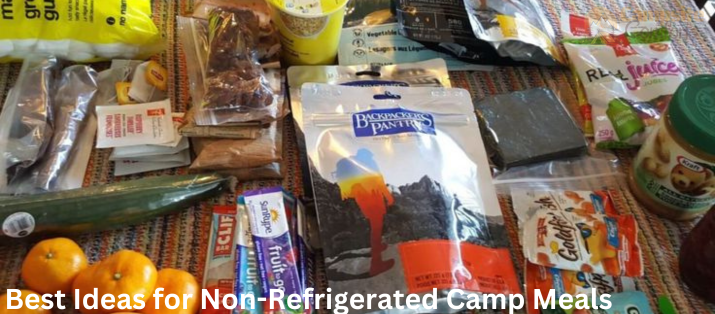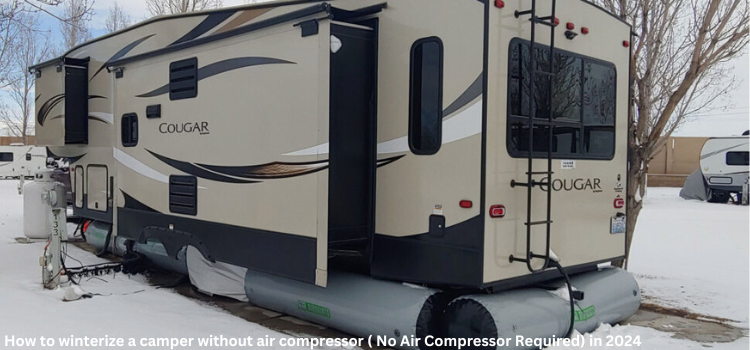When starting on a camping adventure, one of the most common challenges is keeping food fresh without the luxury of refrigeration. Whether you’re exploring the backpacking through rugged terrain, or simply enjoying a weekend getaway in nature, planning meals that don’t require refrigeration is essential for convenience, safety, and enjoyment.
The key to successful camp meals without refrigeration lies in selecting ingredients that are shelf-stable, non-perishable, and resistant to spoilage at room temperature. By choosing the right combination of foods and utilizing smart storage techniques, you can create satisfying meals that fuel your adventures without the need for a cooler or access to electricity. In this guide, we’ll explore a variety of meal options, ingredients, and tips for planning and preparing camp meals that are both practical and delicious, allowing you to focus on enjoying the great outdoors without worrying about any of your food.

Benefits of cooking without refrigeration while camping:
Preservation of Limited Resources:
Cooking without refrigeration conserves precious resources such as ice, which may be in short supply during camping trips. By eliminating the need for a cooler, you can allocate space and weight for other essentials like water, gear, and supplies, enhancing the overall efficiency of your camping experience.
Simplified Meal Preparation:
Without the reliance on refrigeration, meal planning becomes more straightforward and hassle-free. You can focus on selecting shelf-stable ingredients that require minimal preparation and cooking time, allowing you to spend less time in the kitchen and more time enjoying outdoor activities with friends and family.
Reduced Environmental Impact:
Refrigeration typically requires energy consumption, whether through traditional electric coolers or ice replenishment. By non-refrigerated cooking methods, you minimize your environmental footprint and contribute to sustainable camping practices. This eco-friendly approach aligns with the principles of Leave No Trace and helps preserve the natural beauty of areas for future generations to enjoy.
Versatility in Meal Options:
Cooking without refrigeration encourages creativity and experimentation with a wide range of ingredients and recipes. From hearty one-pot meals to tasty snacks and desserts, the possibilities are endless when you embrace the challenge of preparing meals without relying on refrigeration. This versatility allows you to adapt to changing weather conditions, food preferences, and culinary preferences while maximizing the enjoyment of your camping experience.
Essential items to pack for cooking without refrigeration:
Shelf-Stable Ingredients:
Pack a variety of shelf-stable ingredients that do not require refrigeration, such as canned beans, tuna, dried fruits, nuts, grains (like rice and quinoa), pasta, and powdered milk. These non-perishable items can serve as the foundation for numerous meals and snacks during your camping trip.
Portable Cooking Equipment:
Invest in lightweight and portable cooking equipment specifically designed for outdoor use, such as a camping stove, portable grill, or backpacking stove. These compact cooking tools allow you to prepare meals efficiently without relying on traditional kitchen appliances or electricity.
Cooking Utensils and Tools:
Don’t forget to pack essential cooking utensils and tools, including a durable pot or pan, utensils (like a spatula, spoon),, can opener, and measuring cups/spoons, for compact and multi-functional items to save space and minimize weight in your camping gear.
Sealable Containers and Bags:
Use sealable containers and bags to store leftover ingredients, prepared meals, and snacks. Choose containers that are airtight and leak-proof to prevent spoilage and contamination, especially in outdoor environments where exposure to moisture and pests is common.
Non-Perishable Condiments and Seasonings:
Pack a selection of non-perishable condiments and seasonings to add flavor and variety to your camp meals. Consider items like salt, pepper, spices, herbs, hot sauce, mustard, ketchup, and vinegar, which can enhance the taste of dishes without the need for refrigeration.
Disposable Plates, Bowls, and Utensils:
Disposable or biodegradable plates, bowls, and utensils to minimize cleanup and reduce the need for washing dishes in outdoor environments. Choose eco-friendly options made from sustainable materials like bamboo or compostable paper to minimize environmental impact.
Non-Perishable Food Options for Camp Meals:
By picking up on these important non-perishable food items, you can ensure that you have a variety of tasty and nutritious options to enjoy during your camping trip, without the need for refrigeration.
Canned Protein Sources:
Canned protein sources like beans, lentils, chickpeas, and canned tuna or chicken are excellent non-perishable options for camp meals. These canned goods are convenient, versatile, and packed with essential nutrients, making them ideal for quick and easy meal preparation in outdoor settings.
Dried Fruits and Nuts:
Dried fruits and nuts are nutritious, energy-dense snacks that require no refrigeration and can be enjoyed on the go. Pack a variety of dried fruits such as raisins, apricots, and cranberries, along with nuts like almonds, walnuts, and cashews to provide a satisfying boost of energy during outdoor activities.
Dehydrated Meals:
Dehydrated meals are lightweight, compact, and require minimal preparation, making them perfect for camping trips where refrigeration is not available. Simply add hot water to rehydrate the meal, and you’ll have a hearty and satisfying dish ready to enjoy in minutes. Look for dehydrated options like soups, stews, pasta dishes, and rice meals in outdoor stores or online retailers.
Shelf-Stable Dairy Alternatives:
Shelf-stable dairy alternatives such as powdered milk, powdered coconut milk, and powdered cheese can be used to add creaminess and flavor to camp meals without the need for refrigeration. These convenient options are lightweight, easy to pack, and can be reconstituted with water to create dairy-free versions of your favorite dishes.
Whole Grains and Pasta:
Whole grains like rice, quinoa, couscous, and pasta are hearty staples that can be cooked quickly and served as a base for a variety of camp meals. These non-perishable carbohydrates provide sustained energy and are perfect for filling up hungry campers after a day of outdoor activities.
Jarred or Packaged Sauces:
Jarred or packaged sauces such as marinara sauce, pesto, salsa, and curry paste are flavorful additions to camp meals that require no refrigeration. These convenient condiments can be paired with protein sources, grains, and vegetables to create delicious and satisfying dishes with minimal effort.
Shelf-Stable Snacks:
Don’t forget to pack a selection of shelf-stable snacks like granola bars, trail mix, crackers, and jerky to keep hunger at bay between meals. These portable snacks are convenient for on-the-go during hikes, sightseeing, or relaxing around the campsite.
Camp meals that require no refrigeration recipes and ideas:
By taking these options, you can strategically plan your camping menu to include a variety of delicious and nutritious foods that require no refrigeration, allowing you to enjoy your outdoor adventure to the fullest.
Breakfast Options:
Overnight Oats:
- Combine rolled oats with powdered milk, chia seeds, dried fruits, and a sweetener of your choice in a sealable container. Add water or non-perishable milk alternative, stir well, and let it sit overnight. In the morning, top with nuts or seeds for added crunch and enjoy a nutritious and satisfying breakfast.
Breakfast Burritos:
- Fill tortillas with canned beans, scrambled eggs (using powdered eggs if preferred), cheese, and salsa. Wrap them tightly in foil and heat over in portable stove until warmed through. Customize with additional toppings like avocado, diced tomatoes, or hot sauce for a flavorful morning meal.
Lunch Ideas:
Peanut Butter and Banana Wraps:
- Spread peanut butter on a tortilla, then add sliced bananas and a drizzle of honey. Roll up the tortilla and slice it into bite-sized pieces for a quick and portable lunch option that’s packed with energy and protein.
Tuna Salad Lettuce Wraps:
- Mix canned tuna with mayonnaise or mashed avocado, diced celery, and seasonings like salt, pepper, and lemon juice. Spoon the tuna salad onto large lettuce leaves, wrap them up, and enjoy a refreshing and nutritious lunch without the need for bread.
Dinner Recipes:
One-Pot Pasta Primavera:
- Cook pasta in boiling water according to package instructions, then drain and set aside. In the same pot, sauté canned vegetables such as diced tomatoes, bell peppers, zucchini, and mushrooms with garlic and olive oil. Add the cooked pasta back to the pot, toss well, and season with herbs and grated Parmesan cheese for a satisfying dinner.
Campfire Chili:
- In a large pot, combine canned beans (such as kidney beans, black beans, and pinto beans), canned tomatoes, diced onions, bell peppers, garlic, chili powder, cumin, and paprika. Let it simmer over a campfire or portable stove until flavors meld together, then serve with cornbread or tortilla chips for a hearty and comforting meal.
Snack Suggestions:
Trail Mix:
- Mix together a combination of dried fruits, nuts, seeds, and chocolate chips for a portable and energy-boosting snack that’s perfect for munching on during hikes or outdoor activities.
Rice Cake with Almond Butter:
- Spread almond butter on rice cakes and top with sliced bananas or berries for a satisfying and nutritious snack that requires no refrigeration. The combination of protein, healthy fats, and carbohydrates will keep you fueled throughout the day.
Tips for Storing Food Without a Fridge While Camping:
By following these tips for storing and preparing food on a camping trip without a fridge, you can enjoy delicious and satisfying meals while immersing yourself in the beauty of the great outdoors. With careful planning and preparation, you can create memorable camping culinary experiences that nourish both body and soul.
Use Insulated Coolers or Containers:
While you may not have access to a traditional fridge while camping, insulated coolers or containers can help maintain the temperature of certain foods for a limited time. Consider investing in a high-quality cooler with thick insulation and a tight-sealing lid to keep perishable items like fruits, vegetables, and dairy products cool for a few days, especially if you’re camping in a shaded area or cooler climate.
Dry Ice or Ice Packs:
If you’re camping for an extended period or need to keep food items colder for longer, consider using dry ice or reusable ice packs to supplement your cooler storage. Dry ice can keep food frozen for several days and is ideal for preserving meats, seafood, and other perishable items. Reusable ice packs are a more eco-friendly option and can be refrozen at campsite facilities if needed.
Store Food in Shaded Areas:
When setting up your campsite, choose a shaded area away from direct sunlight to store your food supplies. Exposure to heat can accelerate spoilage and increase the risk of foodborne illness, so it’s essential to keep perishable items out of the sun as much as possible. Utilize natural shade from trees or set up a tarp or canopy to create a sheltered storage area for your food.
Practice Proper Food Packing and Organization:
Pack perishable and non-perishable items separately to prevent cross-contamination and ensure storage conditions. Keep raw meats, poultry, and seafood in sealed containers or resealable bags to prevent leakage and minimize the risk of contamination. Organize your cooler or storage containers with the items you’ll need first at the top for easy access without disturbing the entire contents.
Minimize Opening and Closing of Containers:
Limit the frequency of opening and closing your cooler or storage containers to maintain the internal temperature and prolong the freshness of your food. Each time you open the lid, warm air enters the cooler, causing the temperature to rise and potentially compromising the safety of perishable items. Plan ahead and retrieve all necessary ingredients or snacks in one go to minimize heat.
Utilize Natural Cooling Methods:
Take advantage of natural cooling methods like burying food items in the ground or submerging them in a nearby stream or lake (secured in waterproof containers) to keep them cool without the need for refrigeration. These techniques can be effective in maintaining lower temperatures, especially in shaded areas or during cooler times of the day, such as early morning or evening.
Creative ways to store and keep food fresh without a fridge:
Utilize Thermal Cookware:
Thermal cookware, such as vacuum-insulated food jars or thermal lunchboxes, can help keep cooked meals hot or cold for extended periods without the need for refrigeration. Prepare meals in advance and store them in insulated containers to maintain their temperature and freshness until mealtime.
Employ Natural Cooling Techniques:
Take advantage of natural cooling techniques, such as burying food items in a shallow hole in the ground or placing them in a running stream or river (secured in waterproof containers). The natural coolness of the earth or flowing water can help preserve the freshness of perishable items, especially in shaded areas or during cooler times of the day.
Use Evaporative Cooling:
Evaporative cooling is a simple and effective way to keep fruits and vegetables fresh without refrigeration. Dampen a cloth or paper towel and wrap it around the produce before placing it in a breathable container or mesh bag. As the water evaporates, it draws heat away from the food, creating a cooling effect that helps prolong its freshness.
Utilize Salt as a Preservative:
Salt has been used as a natural preservative due to its ability to draw moisture out of food and inhibit the growth of bacteria. Pack foods like cured meats, cheese, and pickled vegetables, which contain high levels of salt, to help extend their shelf life without refrigeration. Just be mindful of your sodium intake and low-sodium options when possible.
Embrace Drying and Dehydrating:
Drying and dehydrating are effective methods for preserving fruits, vegetables, meats, and herbs without refrigeration. Invest in a food dehydrator or use the sun’s heat to dry foods naturally. Once dried, store the items in airtight containers or resealable bags to protect them from moisture and pests, ensuring they stay fresh and flavorful throughout your camping trip.
Alternative options for keeping food cold while camping:
By implementing these alternative strategies, you can effectively keep perishable items cold without a fridge during your camping adventures. With careful planning and preparation, you can enjoy fresh and delicious meals even in the great outdoors.
Frozen Water Bottles:
Freeze several water bottles before your camping trip and use them as makeshift ice packs in your cooler. Not only do frozen water bottles help keep perishable items cold, but they also provide a refreshing source of hydration as they melt. As an added bonus, you can drink the chilled water as it thaws, reducing the need to carry excess liquids.
Wet Towels or Cloths:
Wrap perishable items in damp towels or cloths and place them in your cooler to create a natural evaporative cooling effect. As the water evaporates, it draws heat away from the food, helping to maintain lower temperatures inside the cooler. Reapply the damp towels as needed to maximize the cooling effect throughout your camping trip.
Insulated Food Bags or Pouches:
Invest in insulated food bags or pouches designed specifically for outdoor use. These lightweight and portable containers are equipped with thermal insulation to help keep food items cold without the need for a traditional cooler. Pack perishable items tightly in insulated bags and store them in a shaded area to minimize heat exposure and prolong freshness.
DIY Ice Packs:
Create your own DIY ice packs using simple household materials like sponges, zip-top bags, and water. Soak clean sponges in water, then place them in zip-top bags and freeze until solid. Once frozen, these homemade ice packs can be placed in your cooler to help keep food cold and prevent spoilage. As the ice packs melt, the sponges absorb the water, reducing the risk of leaks or spills.
Utilize Natural Cold Sources:
Take advantage of natural cold sources such as shaded areas, rock overhangs, or bodies of water to help keep your food cold while camping. Position your cooler strategically in a shaded spot or partially submerge it in a nearby stream or lake to benefit from the natural cooling properties of the environment. Just be sure to secure your cooler to prevent it from floating away or being affected by wildlife.
Conclusion:
It is possible to enjoy delicious and satisfying meals while camping without the need for refrigeration. With some planning, creativity, and a few essential tools, you can create tasty and nutritious dishes that will keep you fueled throughout your trip. Whether you are backpacking or simply looking for new meal options for your next camping trip, these no refrigeration camp meals are sure to satisfy your taste buds and make your outdoor adventure even more enjoyable.
FAQS:
What food is good for long term camping?
As snacks, consider whole-grain crackers, almonds, and seeds along with dried fruits. Since dehydrated meals simply need water and are lightweight, they’re also excellent for extended travels. The finest camping recipes to attempt are these ones if you’re searching for something heartier.
Which meats for lunch don’t require refrigeration?
Salami, pepperoni, summer sausage, and sausage sticks are examples of cured meats that are suitable for camping and don’t require refrigeration. By including cheeses and olives, you may turn it into a meal by making a camping cheese and meat board.
Which meat keeps the longest outside of refrigeration?
Bring meat that doesn’t require refrigeration as a solution. Certain meat items that are preserved in cans do well in cool, dry environments. Protein replacements that work include canned chicken, chicken packets, sausage links, precooked bacon, beef jerky, and canned ham.






